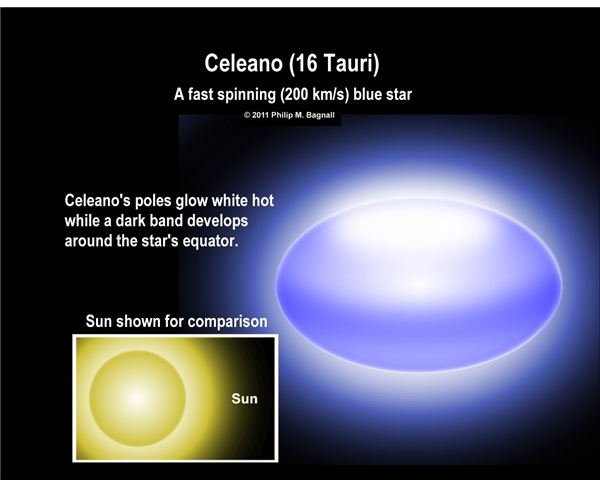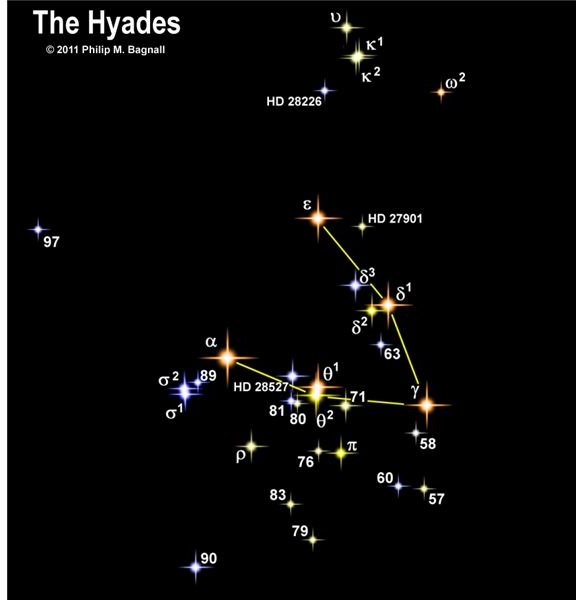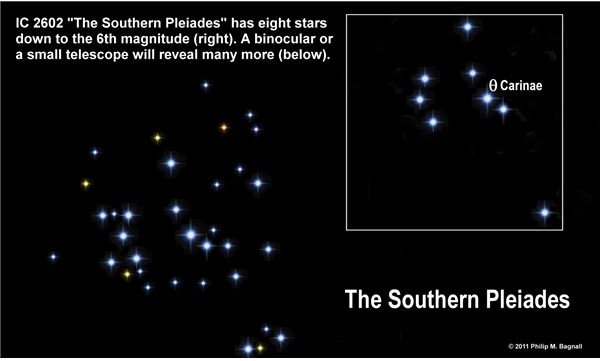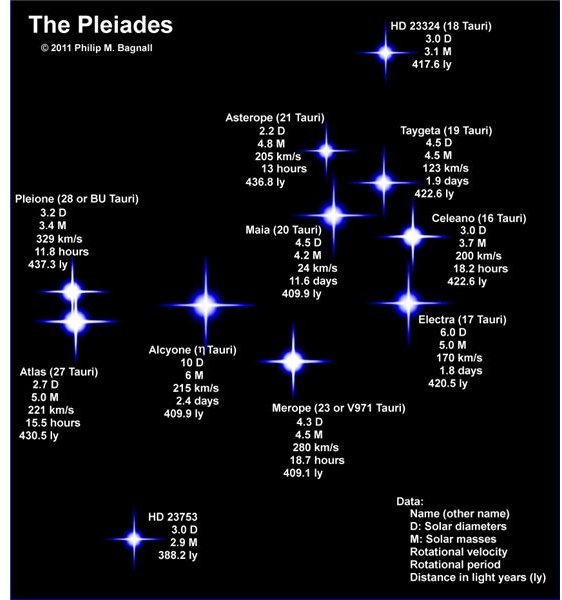Exploring Two of the Most Magnificent Open Clusters in the Night Sky: the Hyades and the Pleiades.
The Pleiades
Let’s start with the Pleiades. In mythology the “Seven Sisters”, as they are otherwise known, are related to the Hyades: they are half-sisters with Atlas being the common father. In reality, the two clusters have no connection. Most people with good eyesight can easily count seven stars and, on a dark night, can probably spot four more. The sisters are known as Alcyone, Asterope, Celaeno, Electra, Maia, Merope and Taygeta. Their father is Atlas and their mother Pleione. Yet, despite being members of the same cluster there is a fair amount of diversity among these stars.
The closest of the sisters is Celaeno, who is sometimes given her Flamsteed number of 16 Tauri. She lives 384.4 light years from Earth, nearly 53 light years closer to us than her mother Pleione, the farthest of the Pleiades. However, despite her proximity she is by no means the brightest star in the group. In fact, she’s the 9th brightest of the 11 stars. Perhaps not surprisingly, Celaeno is one of the smaller sisters at “just” three times the size of our own Sun. Unlike our Sun, she’s really hot! She burns at about 13,000 K compared to the Sun’s more modest 6,000 K. All the stars in the Pleiades cluster belong to the B-spectral class: hot, young, blue, massive stars. Celaeno is a B7, almost in the middle of the spectral class, and she spins on her axis at about 200 kilometers per second (447,400 mph) – 100 times faster than the Sun – so although Celaeno is much bigger than the Sun, she turns once in just 18.2 hours. The Sun takes about 25 days.

When stars spin as fast as Celaeno strange things start to happen. Centrifugal forces cause the equator to bulge outwards spraying material into space, while gravity pulls the poles inwards causing the star to deform into an oblate spheroid. The column of plasma – the gasses and atomic particles – trapped between the poles becomes highly compressed and turns super hot, its temperature increasing by millions of degrees. If you have ever inflated a bicycle tire using a hand-held pump, then you will have noticed the pump getting warmer as the gasses within are repeatedly compressed. It is similar to what is happening inside fast spinning stars, though on a much larger scale! Meanwhile, the plasma around the star’s equator expands and thins out with less pressure to constrain it. As a result it cools. The color of a star is related to its temperature, so rapidly rotating Celaeno looks nothing like the Sun. The high temperature at the poles makes them glow white-hot, while the equator cools to around 8,000 K and darkens. So between the poles and the equator the color gradually changes from white to dark blue. We think. Until we manage to image such stars we will never know for sure. What we do know is that our own Sun is sometimes covered in spots that appear very dark red or black against a yellow background. This is because the Sun over all is about 6,000 K while the spots are only about 3,000 K. But if we could remove a spot from the Sun and place it in the sky it would far outshine every other star. It only looks so dark because of the contrast with the much lighter, hotter background of the Sun. This darkening of a star’s equator is known as the Von Zeipel effect.
Celaeno is by no means the fastest spinning of the Pleiades. Three of her sisters spin faster: Asterope at 205 km/s (458,600 mph), Alcyone at 215 km/s (480,950 mph) and Merope at 280 km/s (626,350 mph), as do both her parents: Atlas 212 km/s (474,230 mph) and Pleione at a breakneck 329 km/s (735,950 mph).
Celaeno is not alone. A smaller, cooler 8,370 K companion orbits Celaeno at a distance of 1 Astronomical Unit (AU) – the same distance Earth lies from the Sun – but takes just 176 days to complete a full orbit. Five others are also binary systems. Electra’s companion takes 100.5 days to orbit the star at an average distance of 0.8 AU. Alcyone’s binary lies at 3.2 AU, while Taygeta’s is a bit farther out at 4.6 AU and has an orbital period of 3.2 years. Pleione’s companion takes 25 years to complete an orbit at an average distance of 28 AU, while at 52 AU from Atlas an unseen star has a period of 150 years, their orbit being lined up in such a way that from Earth we cannot visually separate the two stars. Instead we have to rely on tell-tale signs in the spectrum of Atlas.
The brightest of the Pleiades is Alcyone, otherwise known as η Tauri (the Greek character is pronounce “eta”) which lies at 417.6 ly, a little past mid-way into the cluster. It is the biggest and most massive of the stars coming in at 10 times the diameter of the Sun and six times as massive. It twinkles, of course, but otherwise its magnitude is rock steady, unlike Merope, which varies in brightness by about 0.24%, Atlas by 0.55% and Pleione by a much more noticeable 15.30%.
Photographs of the Pleiades often show them to be embedded in a bluish nebula, and it was once believed that the two were associated. Current thinking is that the cluster is just passing through the nebula. The stars we see with the naked eye are just the tip of the cosmic iceberg. There are likely to be about another 1,000 stars in the cluster with a total mass of around 800 Suns. It is thought to be about 100 million years old and is dispersing: 250 million years from now the Pleiades will not be recognizable as a cluster.
The Hyades

By comparison, the Hyades is much older, more dispersed and contains fewer stars with some of the original members having been gravitationally tugged away as the cluster journeys through the galaxy. This V-shaped arrangement marks the head of the Bull and displays about 20 stars visible to the naked eye. But things are not what they seem. The brightest star in the V, α Tauri (alpha), is not actually a member of the cluster, and nor are π (pi) and 75 Tauri. α Tauri, better known as Aldebaran, is sometimes depicted on paintings of the constellation as being the bloodshot eye of the Bull, being an orange giant some 45 times bigger than the Sun (it would just fit between the Sun and Mercury). But it is only 65.7 ly away, less than half the distance of the cluster.
The biggest star visible without optical aid is ε Tauri (epsilon) at 14 times the size of the Sun and twice as massive. It is not entirely unlike the Sun. A yellowish-orange G9.5 or K0 spectral class (the Sun is a G2) lying 155 ly away. In a 1.6 year long orbit around the star is a gaseous giant planet, about 7.6 times more massive than Jupiter. It was the first planet to be discovered orbiting a cluster star.
You could be forgiven for thinking that θ1 Tauri (theta) is related to θ2 Tauri although they are both binaries. θ1 Taui is a yellowish-orange giant, 10.3 solar diameters across and weighing in at 1.88 solar masses. Its companion is a pale yellowish star about 20% bigger than the Sun and locked in 16.3 year long orbit. This binary pair lie somewhere between 152 and 164 ly from Earth. θ2 Tauri, on the other hand, is almost four times the size and two-an-a-half times the mass of the Sun and is yellowish-white. It also has a yellowish but invisible companion of three solar diameters and 1.8 solar masses in a 140.7 day orbit. This pair is between 144 and 154 ly away.
The Hyades cluster is about 136 ly across and contains up to 400 stars, which are all moving in the general direction of Betelgeuse in Orion, a journey that will take another 780,000 years. The cluster was born about 625 million years ago and is probably associated with the Praesepe in Cancer.
Meanwhile, down south…

If you live or travel south of Guatemala you will get a good view of a cluster that has come to be known as the Southern Pleiades in the constellation of Carina. A very young cluster, just 32 million years old, IC 2602, to give it its catalog number, is about 525 ly from Earth. Its brightest star is θ Carinae (theta), which does not have a proper name despite several web sites stating that it is called Vathorz Posterior, the result of a schoolboy prank.
References
-
Bagnall, Philip M. The Star Atlas Companion (Springer Praxis March 2012)
The Pleiades and surrounding nebula, http://apod.nasa.gov/apod/ap060109.html
3D map of The Hyades, http://www.atlasoftheuniverse.com/250lys.html
